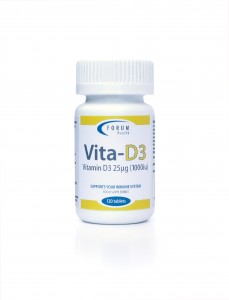 As autumn follows a summer exceedingly short on sunshine, 1 in 6 of us are already at risk of suffering a severe deficiency of vitamin D, which is essential for the absorption in the gut of calcium and phosphorous from food to build strong bones and teeth. It also supports the immune function.
As autumn follows a summer exceedingly short on sunshine, 1 in 6 of us are already at risk of suffering a severe deficiency of vitamin D, which is essential for the absorption in the gut of calcium and phosphorous from food to build strong bones and teeth. It also supports the immune function.
Also known as the ‘sunshine vitamin’, a 20-minute exposure to sunlight 2 – 3 times per week in the UK is usually all it takes for fair-skinned person to replenish their supply of vitamin D. Older people whose skin is thinner and children wearing high sun protection factor creams (SPF 15 and above) may not receive the amount of UVB radiation necessary. Ethnic minorities are more susceptible to vitamin D deficiency because darker skin doesn’t absorb it as efficiently in cooler climates and those with pigmented skin or who need to wear particular clothing for cultural reasons may also be missing out.
Get in the sun
This year the National Osteoporosis Society launched its fifth Sunlight Campaign to remind people across the UK to get outside for a few minutes every day between to keep their vitamin D levels topped up. A survey carried out by the society questioned 600 people in the UK, found that 62% of respondents understood that we need vitamin D to keep our bones healthy, but while a third correctly believed that the best way to get vitamin D is by going outside in the sun without sunscreen, another third thought that you should wear sunscreen. While they are correct that sunscreen is needed to protect the skin, it is important to allow a few minutes of sunlight to make vitamin D (taking care not to burn if you have sensitive skin).
Siobhan Hallmark, spokeswoman for the National Osteoporosis Society comments, “We have run the Sunlight Campaign for the past five years to improve awareness of vitamin D and bone health and we’re pleased that our latest survey shows that the public understanding is definitely improving, but there is still a lot of confusion and a lot of people still think that you should wear sunscreen all the time. It is worrying that this uncertainty could mean that a lot of people are not getting the vitamin D they need, and could be putting themselves at risk of weaker bones.”
Additional D
The survey has also identified confusion around dietary sources. When asked if they took a vitamin D supplement, almost half of respondents said that they didn’t need to because they ate a healthy balanced diet, but actually only a small amount of our vitamin D comes from food sources. Although a healthy balanced diet is important for our all-round health, we really do need summer sunlight to maintain our vitamin D levels.
Less than 10% of vitamin D comes from food. Omega-3 rich foods, such as oily fish, egg yolks and fortified spreads and cereals contain some vitamin D but not enough. Taking a vitamin D3 (cholecalciferol) supplement – such as Vita-D3 can help counter the effects of vitamin D deficiency in those most at risk such as children, young adults and the elderly. Available from pharmacies, health food stores or mail order from Forum Health Products, where it is on promotion with a year’s supply for just £10.99 www.forum-health.co.uk.
Sunlight Campaign
- Sunlight is the best natural source of Vitamin D. Vitamin D helps our bodies to process calcium effectively and is essential for healthy bones.
- Exposure to sunlight every day between 11am and 3pm from May until September will increase Vitamin D and help to keep bones healthy
- You should try to get 10 minutes of sun exposure to your bare skin, once or twice a day (depending on skin type), without sunscreen and taking care not to burn.
- Always take care not to burn, especially during the strong sunshine in the middle of the day. Babies and children have very sensitive skin and need careful protection.
- Even on cloudy days, your body can still produce Vitamin D from sunlight but it can take a little longer.
- Get outside between May and September so that your body can produce enough Vitamin D to help see you through the winter months.
- Make sure that you are actually outside. Your body cannot produce Vitamin D even if you are sitting by a window or in a conservatory on a sunny day. You must be outside.
- Only a small proportion of vitamin D comes from the food we eat, but it is still important to include vitamin D rich foods in your diet, such as oily fish and eggs. Many margarines, breakfast cereals and dairy alternatives are fortified, but do check the label.
- If you are 65+ years, not exposed to much sun (e.g. housebound or cover-up for cultural reasons) or a pregnant or breast-feeding woman, you should consider taking a daily, 10 micrograms (400IU), vitamin D supplement.
DID YOU KNOW?
- Only about 10% of our vitamin D comes from food.
- If your skin starts to burn, your body will begin to deplete the vitamin D that it has produced so safe sun is always best.
- If your shadow is shorter than you, the sun is at the right angle to produce vitamin D.
- Your body cannot produce vitamin D thorough windows – you need to be outside.
- Even on cloudy summer days, we can still produce vitamin D but it can take a little longer.
See the full issue of the August Desang online magazine by clicking HERE.
[issuu width=420 height=297 backgroundColor=%23222222 documentId=120819145442-da7c078b929a46d8bec26de6159cdb84 name=desang_mag_issue_26_aug_2012 username=desangmedia tag=accu-chek unit=px v=2]


